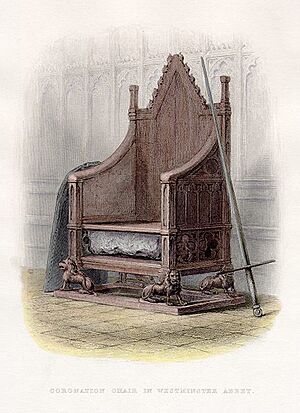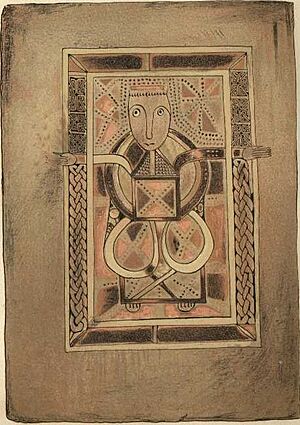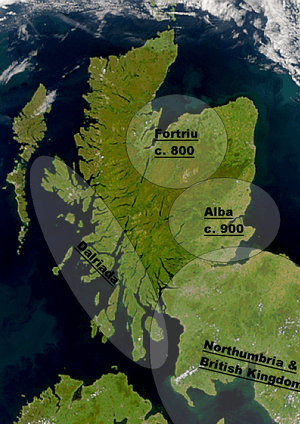Kingdom of Alba facts for kids
The Kingdom of Alba was the name for Scotland between the years 900 and 1286. It started with the death of King Donald II and ended with the death of King Alexander III. Alexander III's death later led to an invasion by Edward I of England in 1296. This started the First War of Scottish Independence.
Alba included the area of Dalriada. But it did not include large parts of what is now the Scottish Lowlands. These areas were then part of other kingdoms like Strathclyde and Northumbria. Fortriu, a Pictish kingdom in the north, joined Alba in the 900s.
Until the early 1200s, Moray was not fully part of Alba. Alba was mostly seen as the land between the Firth of Forth and the River Spey.
The name "Kingdom of Alba" is used by historians today. During this time, the rulers and most people were mainly Pictish-Gaels. Later, they were Pictish-Gaels and Scoto-Normans. This was different from the time of the House of Stuart (starting in 1371). Then, the rulers mostly spoke Middle English, which became Lowland Scots. In Gaelic, Rìoghachd na h-Alba means 'Kingdom of Scotland'. Scholars use "Kingdom of Alba" to talk about this specific time in Scottish history.
Contents
Royal Court and Government
We do not know much about the Scottish royal court before the Normans arrived. This was before the reign of David I. We know a bit more about the court in the later 1100s and 1200s. Historian Geoffrey Barrow said this court was "feudal, Frankish, non-Celtic in character." This means it was like the courts in France and England. Some jobs were Gaelic in origin. For example, the Hostarius was in charge of the king's bodyguards. The rannaire was a Gaelic speaker who divided the food.
Here are some important jobs in the royal court:
- The Seneschal (or Steward) was in charge of the royal household. This job was passed down in families since David I's time.
- The Chancellor was in charge of the royal chapel. This was the king's place of worship. It was also where royal records were kept. The chancellor was usually a church leader. They often became a bishop later.
- The Chamberlain managed the king's money.
- The Constable was in charge of the king's army. This job was also passed down in families since David I's time.
- The Butler managed the king's wine and food.
- The Marshal (or Marischal) was in charge of the king's cavalry (soldiers on horseback).
In the 1200s, most of these jobs became hereditary. This means they were passed down from father to son. Only the Chancellor's job was not usually hereditary. The royal household also had many other roles. The hostarius was very important. There were also royal hunters, foresters, and cooks.
Kings of Alba
Early Kings: Donald II and Constantine II
King Donald II was the first king called rí Alban (King of Alba). He died in 900 at Dunnottar. Before him, kings were called "King of the Picts" or "King of Fortriu". This change in name might mean Scotland was beginning. But nothing special happened in his reign to confirm this. Donald had the nickname dásachtach, which meant "madman." This might be because he fought many battles against Vikings.
Donald's successor, Constantine II, is often seen as key to forming Alba. Constantine ruled for almost 50 years. He fought many battles. After losing at Brunanburh, he became a Culdee monk. Later stories praise Constantine. He is said to have helped the Catholic Church in Scotland become more like the church in the wider Gaelic world. We do not know exactly what this means. There had been Gaelic bishops in St. Andrews for 200 years. The reform might have been about how the church was organized.
From Malcolm I to Malcolm II
The time from King Malcolm I (942/3) to King Malcolm II was important. During this time, Scotland had good relations with the English kings. There were also many family fights for the throne. But Scotland still managed to expand its lands.
Around 945, the English king gave the area of cumbra land (either Strathclyde or Cumbria) to King Malcolm I. This was in return for a lasting alliance. Later, King Indulf (954–962) captured the fortress of oppidum Eden, which was likely Edinburgh. This was Scotland's first hold in Lothian. Scotland probably had some power in Strathclyde since the late 800s. But Strathclyde kept its own rulers. King Cuilén, one of Indulf's successors, was killed by men of Strathclyde. King Kenneth II (971–995) started his reign by invading Britannia (possibly Strathclyde). This might have been to show his power.
Malcolm I's reign also saw the first problems between Scotland and Moray. Moray was the old heartland of the Pictish kingdom of Fortriu. The Chronicle of the Kings of Alba says King Malcolm "went into Moray and slew Ceallach." It also says Malcolm was killed by the Moravians. This shows the first tension between two main family groups, the Cenél nGabráin and Cenél Loairn. These groups claimed to be related to different ancestors of Erc. Later, Macbeth and Lulach, who were from Moray, ruled all of Scotland.
Malcolm II's reign saw these lands fully join Scotland. A key year was 1018. King Malcolm II defeated the Northumbrians at the Battle of Carham. In the same year, King Owain Foel died. He left his kingdom to Malcolm. A meeting with King Canute of Denmark and England around 1031 helped secure these gains. But Scottish rule over Lothian and the Scottish Borders was not fully strong until the Scottish Wars of Independence.
From Duncan I to Alexander I

The time from King Duncan I (1034) to the death of Alexander I (1124) was the last before the Normans came to Scotland. King Malcolm III's reign hinted at changes that would come. These changes happened under the French-speaking kings David I and William I.
King Duncan I's reign was not successful in war. He was defeated in 1040 and later overthrown. Duncan was related to previous rulers only through his mother, Bethoc. She was the daughter of Malcolm II. At a place called Bothganowan (meaning "Blacksmith's Hut"), Macbeth, the ruler of Moray, defeated and killed Duncan. Macbeth then became king. After Macbeth and his successor Lulach, all kings of Scotland were Duncan's descendants. Because of this, Duncan is often remembered well, and Macbeth is seen as a villain. William Shakespeare made this story famous in his play Macbeth. Macbeth's reign was successful enough that he even went on a pilgrimage to Rome.
Malcolm III got the nickname "Canmore" (Ceann Mór, meaning "Great Chief"). He did more to create the successful royal family that ruled Scotland for the next two centuries. He had many children from two marriages. First, he married the Norwegian Ingibiorg Finnsdottir. Then, he married the English princess Margaret of Wessex. Malcolm and Margaret brought the first Benedictine monks to Scotland.
Even with an Anglo-Saxon wife, Malcolm spent much of his reign raiding England for slaves. This added to the troubles of the English after the Norman Conquest of England. Malcolm died in one of these raids in 1093. After his death, the Norman rulers of England started to get involved in Scotland. Malcolm's raids and his attempts to claim the English throne for his children caused this. He had married the sister of Edgar Ætheling, an English claimant to the throne. He also supported many English nobles against their Norman rulers. In 1080, William the Conqueror sent his son to invade Scotland. Malcolm submitted to William and gave his oldest son Duncan as a hostage.
Malcolm's natural successor was his brother, Donalbane, because Malcolm's sons were young. But the Norman state sent Malcolm's son Duncan to take the throne. Duncan was killed in 1094, and Donalbane became king again. However, the Norman state sent another of Malcolm's sons, Edgar, to take the throne. This Norman policy worked. After this, all kings of Scotland followed a system like primogeniture. This meant the oldest son usually inherited the throne. The reigns of Edgar and his brother Alexander are not well known. Edgar sent a camel (or elephant) to the High King of Ireland. When Edgar died, Alexander became king. His youngest brother David became Prince of "Cumbria" and ruler of Lothian.
Norman Kings: David I to Alexander III

The time from David I becoming king to the death of Alexander III was important. Scotland had good relations with the English kings. It was also a time when the Scottish kingdom grew a lot. Royal power spread across most of modern Scotland. This period saw many big changes. Historians call it the "Europeanisation of Europe." This means Scotland became more like other European countries.
However, there are some misunderstandings about this time. For example, English did not spread everywhere in the Lowlands. Most native Scottish lords kept their lands. Only a few went to French or Anglo-French people. Also, the Norman influence and the spread of royal power in Scotland were not always peaceful. They were often more violent than the Norman Conquest of England. The Scottish kings were also not fully independent. They were vassals (like a lord owing loyalty) to the King of England, especially for lands south of the Forth.
Important changes during this time included:
- The creation of many burghs. These were Scotland's first towns.
- The adoption of feudal customs for knights, society, and inheritance. This was also called "Francization" (becoming more French).
- Changes in church institutions to be less "Scottish" (Gaelic).
- The spread of royal power over most of modern Scotland.
- A big shift at the top levels away from traditional Gaelic culture. After David I, the Scottish kings were more like French and English kings.
After David I, especially during William I's reign, Scottish kings were not always fond of the culture of most of their people. As one writer, Walter of Coventry, said, "The modern kings of Scotia count themselves as Frenchmen... they keep only Frenchmen in their household... and have reduced the Scots [Gaels] to utter servitude."
The kings' feelings were sometimes shared by their subjects. After King William was captured in 1174, the Scots turned on his English and French-speaking subjects. William of Newburgh wrote that the Scots showed their hatred for the English. They killed many of them. Those who could escape fled to royal castles.
Walter Bower, writing later, also described this event. He said that after the king's capture, the Scots and Galwegians killed their English and French friends without mercy. This persecution of the English was very intense.
Opposition to the Scottish kings was strong during this time. One example is the revolt of Óengus of Moray. After he was defeated, Moray was settled by foreign townspeople and French or Anglo-French nobles. Rebellions continued through the 1100s and 1200s. Important people who resisted the kings included Somhairle Mac Gille Brighdhe, Fergus of Galloway, Gille Brigte of Galloway and Harald Maddadsson. There were also two family groups called the MacHeths and the Meic Uilleim. The Meic Uilleim claimed to be related to King Donnchadh II. They rebelled to claim the Scottish throne. The threat was so serious that after the MacWilliams were defeated in 1230, the Scottish crown ordered the public execution of the last MacWilliam baby girl. The Lanercost Chronicle tells us her head was struck against a market cross.
Many of these resistors worked together. They got support from Gaelic regions like Galloway, Moray, Ross, and Argyll. They also got help from eastern Scotland, Ireland, and the Isle of Man. By the late 1100s, the Scottish kings had enough power to get native Gaelic lords to work for them. Famous examples are Lochlann, Lord of Galloway and Fearchar Mac an t-Sagairt.
This cooperation helped Scotland expand into the Scandinavian-ruled lands in the west. Uilleam, the native ruler of Ross, was key to Scotland's expansion into the Hebrides. So was Ailéan mac Ruaidhrí, a pro-Scottish chief from the Hebrides. He married his daughter to Uilleam, the ruler of Mar. The Scottish king also got support from Alan, Lord of Galloway. Alan controlled the Irish Sea region and had a huge fleet of ships. The rulers of Lennox made ties with the Argyll chiefs. This brought groups like the Campbells into the Scottish kingdom.
By the reign of Alexander III, Scotland was strong enough to take over the rest of the western coast. This happened in 1266 with the Treaty of Perth. Orkney also started to come under Scottish influence. In the 1100s, Mormaer Matad's son Harald became the Earl of Orkney. After that, the Earl of Orkney was loyal to both Scotland and Norway. Descendants of the Gaelic rulers of Angus ruled Orkney for much of the 1200s. In the early 1300s, another Scottish Gaelic noble, Maol Íosa V of Strathearn, became Earl of Orkney. But Scotland did not formally rule the Northern Isles for more than another century.
The conquest of the west, the creation of Carrick in 1186, and the absorption of Galloway after the revolt of 1135 meant that the number of Gaelic speakers under the Scottish king actually grew. It might have even doubled during this "Norman period." It was the Gaels and Gaelicised warriors from the new western lands who helped King Robert I win the Scottish Wars of Independence. Robert I himself was a Gaelicised Scoto-Norman from Carrick. These wars happened soon after Alexander III's death.


